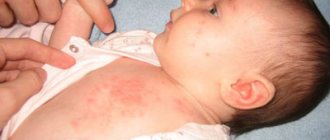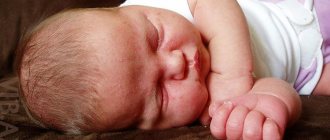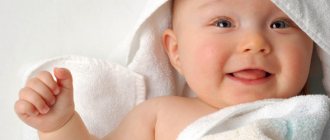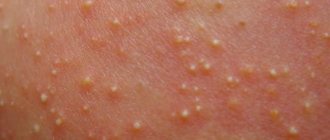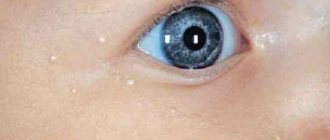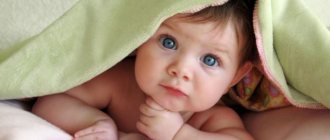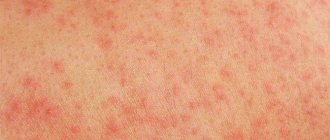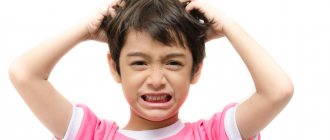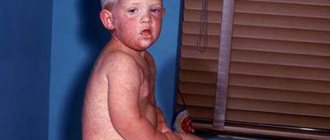What is a rash
These are rashes on the upper layer of the epidermis that are bacterial, viral or infectious in nature. They arise under the influence of a provoking factor and cause itching, swelling, and redness of the skin. In fact, this is one of the manifestations of allergies, which, in the absence of timely treatment, can turn a once healthy person into a “chronic allergy sufferer.” The rash looks disgusting, disrupts the homogeneous structure of the skin, and creates favorable conditions for the development of purulent and infectious processes.
Rules for preventing the appearance of a rash on the back of a child
Most often, a rash on the back in children is the result of an allergy or poor hygiene. In such cases, parents usually know what an allergy may occur to and can cope with this phenomenon themselves.
Hygiene requirements:
- Teach your child to shower every day before bed. The skin should be cleaned with a well-soaped washcloth, then the remaining soap should be completely washed off the body.
- Review your diet. Exclude foods that cause allergies, sweets, fatty, spicy foods. Replenish your diet with neutral dishes that do not cause health problems.
- Review the child’s clothes, check that all of them, especially underwear, are made from natural fabrics.
- Wash children's clothes separately from adults with special hypoallergenic children's powders, set the washing machine to the highest rinse setting.
- Change and wash baby bedding regularly. If a rash appears, the bed is changed daily.
- Wash and bathe children only with products purchased at the pharmacy, intended for use on problem skin.
For any recurrence of a rash on the back, it is necessary to visit a dermatologist, get a new consultation, a new prescription.
A rash on the back should not be left unattended; it causes serious discomfort to the child, and most importantly, it can be a sign of a dangerous internal disease.
Hormonal rash in newborns
Microbes do not always become the main cause of skin rashes; hormonal changes in the body of infancy cannot be ruled out. For example, after the birth of a child, an excess of estrogen predominates for another 2-3 weeks, which leads to enlargement of the mammary glands and the appearance of characteristic rashes on the skin. The phenomenon is temporary, but noticeably frightens young parents. Externally, it is a profuse acne that has dense contents, similar to the signs of acne. However, the pus is not liquid in consistency; it resembles a whole white grain.
Hormonal rash in newborns, also called neonatal, acne, three weeks. You can get rid of the characteristic rashes without medications; you need to wait a few weeks. To remove pimples, a decrease in the concentration of female hormones - estrogens - in the children's body is indicated, which are precisely the main cause of the pathological process.
Neonatal pustulosis of newborns, implying hormonal “blooming of the dermis” in children in the first days of life, is most often localized in the upper part of the body - on the head, neck, face and back. That's why it's called cephalic. To get rid of unpleasant symptoms, it is necessary to observe adequate rules of personal hygiene for the baby. In this case, the disease disappears on its own within 2-3 days.
What is prickly heat
It is not without reason that they say that the temperature in a child’s room should not exceed +22 C. If this condition is not met, the child will certainly sweat a lot. As a result, a small pink rash may appear on the baby's skin, in the folds of the chest and neck, and under the armpits.
The affected area appears slightly swollen. Skin rashes of this kind in children can occur throughout the first year of life. Most often, it does not cause any discomfort to the child. To make prickly heat go away faster, treat the affected areas with baby powder.
Let us recall the reasons why prickly heat appears:
- The temperature in the children's room is too high.
- Failure to comply with the ventilation schedule for the room where the child is located.
- The desire to unnecessarily wrap the baby in warm clothes.
- Insufficient hygiene towards the child.
Parents need to eliminate these causes; soon the baby’s skin will lose its swelling and redness.
Allergic rash in a newborn
The cause of such rashes is exposure to a provoking factor, which may be a food allergen, household chemicals, or skin care cosmetics. In addition, external irritants cannot be excluded from household, natural, or chemical origin. In all cases, the rash in infants looks the same and causes itching, burning, internal discomfort, and emotional instability. This unpleasant symptom characterizes several diseases presented below, so differential diagnosis is required. So:
- Food allergies. More often it appears on children's cheeks due to the penetration of the allergen into the digestive tract. The infection can enter the newborn's body through the mother's breast milk.
- Contact allergies, also called household allergies. Appears when the skin comes into direct contact with external allergens - potentially hazardous substances. The smell of paint or animal hair can provoke such an allergic reaction in a newborn.
- Drug allergy. A red rash becomes a side effect of long-term conservative treatment for a newborn and not only. Due to the weakening of the immune system by the disease, the newborn body is not able to resist partial intoxication of the body from the pills.
- Hives. This is a complicated form of an allergic reaction, in which the red rash is small and profuse. Prone to forming blisters. Externally, the rash resembles a nettle burn, hence the name. A complication for a newborn patient is anaphylactic shock, Quincke's edema.
- Prickly heat. The rash in a baby appears in the folds of the skin due to impaired sweating of these areas. The foci of pathology are the groin, back, armpits, and neck. The main task of parents is to restore the newborn’s heat exchange, dress the baby according to the weather, and remove the rash.
- Diaper dermatitis. Occurs upon contact with wet diapers, since liquid feces and urine irritate sensitive skin. First, irritation appears, and then diaper rash and sores appear. Parents need to follow the rules of personal hygiene for their newborn baby.
- Atopic dermatitis. A common skin disease that causes a blistering rash in a newborn. The foci of pathology are the cheeks and chin, legs and arms, and children’s buttocks. The rash itches and makes the newborn nervous and irritable.
What does hives look like?
This disease has a telling name. The rashes on the baby's body look exactly like a severe burn caused by nettles. The rash is accompanied by obsessive itching. Subsequently, the rash transforms into blisters of different sizes and shapes, affecting the face, head, and body. Urticaria is a severe form of skin allergy that can quickly progress to Quincke's edema.
If you suspect your baby has hives, call a doctor immediately. The disease is the body’s reaction to an allergen - food or household; it can go away on its own, but in no case is it worth the risk.
You should be wary of Quincke's edema - a dangerous complication of urticaria, which causes suffocation. The latter can lead to serious consequences.
Causes of urticaria:
- hypothermia;
- exposure to heat;
- exposure to the scorching sun;
- consequences of severe stress;
- friction from elastic bands on clothes, from car seat straps;
- past infectious disease;
- the presence of helminths in the baby’s body.
After making a diagnosis, the doctor prescribes medications that eliminate allergic manifestations.
To relieve severe itching, you will need special ointments, which will also be prescribed by your doctor. If the disease is very severe, hormonal ointments will provide effective help.
Infectious rashes in newborns
If the cause of a profuse rash on the skin is a viral infection, this condition is fraught with serious consequences for the health of the newborn and not only. Additional symptoms are high temperature, fever, and digestive disorders. Before choosing medications to treat the rash, it is recommended to clarify the diagnosis in the newborn. What kind of illness could this be:
- Chickenpox. The rash is abundant and localized throughout the body. Each pimple has liquid contents. After random opening, the bottle dries up and the crust falls off, temporarily leaving a stain on the body. The description of the characteristic illness is known to all parents, since almost everyone suffered chickenpox in childhood.
- Scarlet fever. The rash spreads throughout the body very quickly; in addition, inflamed tonsils are involved in the pathological process. After eliminating the rashes, noticeable spots remain on the body, prone to peeling. A sick newborn child should be isolated for 10 days and treated urgently.
- Rubella and measles. These are well-known childhood diseases with a profuse rash, which are best tolerated between 1 and 3 years of age without potential complications. In a newborn, the spots merge into large foci, while the patient himself suffers from high temperature and signs of fever.
- Roseola has similar symptoms to rubella. The rash aggregates into large lesions, and the skin is prone to dryness and flaking. The main causative agent of the disease is the simple herpes virus; conservative treatment is complicated. When pressed with a finger it immediately turns pale.
- Thrush. The disease is of fungal origin, and the rash spreads to the mucous membranes of the newborn. The activity of the pathogenic fungus can be suppressed only by conservative methods - a mixture of medications will help. Newborn fungal rash is treated with a steep soda composition.
Causes
A variety of reasons lead to the appearance of rashes on the buttocks of babies. An important criterion for the appearance of such elements is, first of all, the age of the child.
The reasons that contribute to the development of a rash on the butt in a newborn child may be completely different than in a schoolchild or teenager. The severity of the manifestation of unfavorable symptoms of rashes may vary and depend on the initial condition of the baby.
The baby’s small body is very vulnerable to the penetration of various infections. Quite often, they are what cause various rashes on the child’s buttocks.
Bacterial infections can lead to the appearance of various skin elements in the baby, inside of which there is a yellow or bloody fluid. staphylococcal or streptococcal flora leads to the development of such pustules on the skin . Anaerobic microbes cause these forms of the disease much less frequently.
The appearance of a rash on a child’s bottom may indicate simple irritation. This can also happen to a completely healthy baby when wearing the wrong clothes.
In infants, this situation occurs when wearing diapers for a long time . Contact dermatitis in this case is characterized by the appearance of a rash on the buttocks and groin. This condition is quite unpleasant for the baby and can cause severe discomfort in him, as well as a change in his usual behavior.
Babies with skin rashes become more capricious. They can constantly change their position in the crib.
As a rule, contact dermatitis is accompanied by severe itching. This leads to the baby starting to scratch the damaged areas of the skin. This situation is extremely unfavorable, since the child can introduce a secondary bacterial infection into the scratching area, which leads to suppuration and the appearance of various pustules on the skin.
Allergic pathologies cause rashes to appear on the skin of babies quite often. In infants, the appearance of various rashes on the bottom, as a rule, results from the introduction of new food products into their diet in the form of complementary foods. The baby may have an individual hypersensitivity to some of these food components, which contributes to the development of an allergic reaction.
In children aged 2-3 years, allergies usually occur when sweets and chocolate are included in the diet. A fairly common cause of an allergic reaction can be the consumption of honey and various bee products.
The use of inappropriate cosmetics for children is also a very common cause of various rashes appearing on a child’s buttocks and legs. This rash is usually very itchy. Mothers usually notice this sign during daily hygiene procedures.
Older children may notice these symptoms on their own. Causes leading to the appearance of a rash include some childhood infections. These diseases are accompanied by fever, as well as many other unfavorable symptoms.
The high incidence of such infections occurs mainly in organized groups. Most of them are transmitted by airborne droplets, which causes significant morbidity.
Chickenpox, rubella, and measles are accompanied by the appearance of various rashes on the baby’s skin. These diseases lead to the child’s general well-being being greatly impaired.
The mood of a sick child can change quite quickly. Within a few minutes, after the baby cries, he regains his old smile and good mood.
The course of childhood infections is usually moderate , but ends with complete recovery.
Atopic dermatitis
Atopic dermatitis is the most common cause of rash in babies. Localization of the rashes is the back, shoulders, butt and stomach of the child. This happens due to exposure to allergens of various origins (chemical, plant or animal). Excessive dry skin also contributes to the appearance of rashes.
In children, atopic dermatitis can occur due to the use of low-quality children's cosmetics, which are used by parents for hygiene procedures. A rash on a baby's bottom and back indicates that diapers are not suitable for the baby.
Allergic reaction of the body
Babies have allergic reactions to medications and foods, so food and medications are carefully chosen for them.
The allergy manifests itself as redness on the stomach and back. The rash looks like small blisters or pimples of pink color. Also, allergies may cause large pink spots to appear. If a rash appears on the lower back of a baby, then most likely it is an allergy to diapers or heat rash.
Dermatological diseases in children
The cause of red spots that look like blisters can be scabies. The disease is caused by a special parasite. If left untreated, it will spread throughout all the folds of the body.
It is very difficult to notice the parasite. Sometimes you can see black dots under the skin.
Sweating
Occurs mainly in the youngest children. The rashes are white or red. Localization - back. Their appearance is provoked by excessive insulation of the child in sufficiently warm clothes. A small rash on a child’s back is also miliaria.
Chicken pox
Chicken pox is an infectious disease. Localization – back and other parts of the child’s body. The disease has an incubation period. It occurs most easily at a young age.
Rubella
Another infectious disease. Children without a single vaccination against it are at risk. A red rash on a child's back indicates that the baby has rubella.
Vesiculopustulosis
Vesiculopustulosis is a bacterial infection. The rashes look like blisters containing purulent contents. It is treated primarily with antibiotics.
Scabies
- The penetration of scabies mites into the skin leaves typical manifestations on it - flaky pink spots (a consequence of inflammation), on which traces of penetration are visible.
- The disease causes severe itching and irritation.
- There is a danger of infection when scratching. You can become infected through contact with a sick person. Therefore, the affected areas are very different. More often the arms, less often the back and stomach.
Lichen
- Pathology, which is provoked by the penetration of microsporum into the epidermis, as well as trichophytons.
- Fungal rashes take the form of spots with peeling, having a clear border.
- After cleansing the baby's skin, light spots remain.
- Children infected with lichen experience severe itching and can cause a secondary infection when scratching.
Meningitis
- The type of rash depends on the type of pathogen.
- The child's torso becomes covered with small hyperemic spots.
- Skin formations do not cause pain or itch.
- After a certain time, the symptoms increase and the temperature rises.
- Meningitis is characterized by photophobia and lethargy.
- If such a rash and symptoms are detected, urgent hospitalization is necessary - sudden death is likely.
Insect bites
- Household ticks, bedbugs that live in furniture and linen can bite a child. Bites leave marks on the stomach, back, and limbs in the form of a small red rash.
- The skin of children prone to allergic reactions reacts more often.
- Bites from larger insects (bees, wasps, mosquitoes) are more noticeable as pink, itchy lumps that increase in size, are painful and can cause an allergy attack.
Measles
Measles is a common disease among preschool children. Children who have not had measles and are not vaccinated against it fall into the high-risk zone.
How to treat a rash
If acne, prickly heat, or acne symptoms appear on the skin of a newborn, you should urgently contact a pediatric dermatologist. Superficial self-medication is excluded, otherwise the manifestations will become even more abundant. After identifying the provoking factor and completely eliminating it, treatment is conservative, and alternative methods of traditional medicine can be additionally used.
All over the body
If a small itchy rash is spread throughout the body, it is possible that it is prickly heat. To effectively eliminate it, it is important to control the heat exchange of the newborn body, correctly apply the baby to the breast during feeding, and organize bathing in the morning and every evening with the addition of a decoction of chamomile, celandine or string to the water.
On the cheeks
This is an eloquent sign of diathesis. Therefore, before removing a rash from a newborn, you need to review your diet and exclude potential allergens from it. The irritant enters the child's body through breast milk, causing trouble for mother and baby. To relieve unpleasant symptoms, the doctor prescribes mild antihistamines or drink a weak chamomile decoction.
- Glycosylated hemoglobin
- How to freeze chanterelles for the winter
- How to treat obsessive-compulsive disorder and fears
On the neck
This may be a manifestation of contact dermatitis when delicate skin comes into contact with synthetic clothing materials. It is important to exclude contact of the non-born with a potential allergen and additionally use Sudocrem ointment. The drug is non-greasy, does not contain alcohol, will relieve inflammation, swelling and redness, without drying the skin, and reduces areas of skin rash.
On the forehead
In such a clinical picture, the injured child is not recommended to wear a hat, but it is recommended to use a weak solution of potassium permanganate externally, and Fenistil drops internally for children from 1 year of age. It is important that the solution does not get into the ear, moisten the cotton wool and thoroughly treat each wound. Treat until the characteristic rash disappears completely.
On the stomach
This is a characteristic sign of atopic dermatitis, which is prone to a chronic course without timely treatment. The newborn should be given antihistamines and probiotics, according to the age category and the pediatrician’s recommendations, bathe the baby daily in chamomile and string, and be sure to monitor the nutrition of the nursing mother.
In the crotch
This is a characteristic sign of diaper dermatitis in a newborn. To quickly get rid of the characteristic perineal rash, you must carefully observe the rules of personal hygiene of the baby, examine all folds, use powder and diapers only from hypoallergenic materials, buy Bepanten cream for regular treatment of problem areas.
On hands
When a rash appears on the hands, it is important to rule out a childhood infectious disease. To do this, contact a pediatrician together with the newborn, undergo an examination, and differentiate the diagnosis. If the appearance of a rash is preceded by a non-infectious process, the phenomenon is temporary and goes away on its own after the allergen is eliminated from the body. Otherwise, it is recommended to be treated with medication, sometimes with the use of antibiotics.
Around eyes
It is possible that this is the result of using wet wipes that contain fragrances and alcohol. It is necessary to immediately abandon such caring cosmetics, otherwise the characteristic rash will soon become a common occurrence for the newborn. To eliminate allergy symptoms, you can use unsteeped tea as a lotion or chamomile infusion orally
Types of rash
Recently, an article appeared in the British Journal of Dermatology in which Spanish scientists described dermatological problems manifested by coronavirus. The study involved about 400 people infected with coronavirus.
Rash on extremities similar to frostbite
The appearance of a rash on the legs and arms was observed in approximately 20% of cases. Patients often complained of itching and painful sensations when touched. In most cases, such a rash appears in young people who experience a mild form of the disease.
The rash usually appears later than other common symptoms and lasts about 2 weeks.
Blisters
In some patients (16%), very small blisters of the same size and shape appear on the stomach and back. Slightly less often, such blisters appear on the arms and legs (10%).
Blisters most often appear in patients aged 35-55 years and are accompanied by unbearable itching. This rash lasts an average of 10 days.
Maculopapular rash
It looks like small red bumps. In some cases, it may appear along with other common symptoms. Their duration is 8-10 days. It is the most dangerous and common type of rash due to coronavirus (48%).
Hives
The rash, similar to hives, resembles a large number of small bumps that are red or white and very itchy. Many people infected with Covid experienced such a rash on all parts of the body, including on the palms of their hands. Its duration is 7-9 days and is most often observed in patients with a severe form (20%).
Livedo
It is the main sign of tissue death and circulatory problems. It appears as a purple mesh pattern on the skin. Most often occurs in elderly patients with severe disease. This type of rash is very rare.
